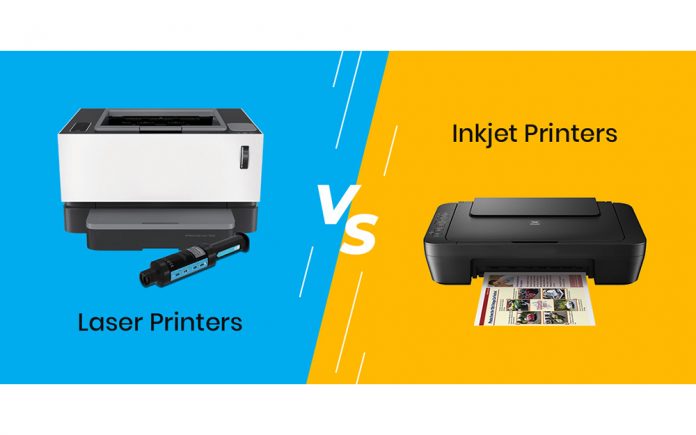
The Differences and which is right for you?
By Dennis Shelly
If you were to ask before the COVID-19 outbreak(s) if printers would be in such high demand? I’d say for home use not really, in fact, many home users didn’t have a printer, well pre-pandemic that is. With the current environment, we have seen a shift in the workforce and workplace. As more people have shifted to “Work from Home” (WFH) printers have become more prevalent for home and less for businesses with on-site office spaces. Understanding the difference between laser and inkjet printers will assist you in making an informed decision for your business or home office.
Now, there are a few differences to be aware of. First, you’ll need to pick between an inkjet printer and a laser printer. Laser printers and inkjet printers remain popular in both the home and the workplace, with each printer design and model having its own set of advantages and pitfalls. This article will show you how to choose a new printer. Here’s a comparison of laser vs. inkjet printers, as well as some of the most important factors to consider when making your purchase.
What Is an Inkjet Printer and How Does It Work?
Inkjet printers use a side-to-side moving print head that sprays small ink droplets onto the paper or media as it passes through the carriage. Thermal inkjet printers generate heat, which causes the ink to evaporate and form bubbles, which then propel the ink onto the pages being printed. Other printers may employ piezoelectricity to generate movement by moving small crystals that shoot ink. To generate the final printed image, tiny drops of ink too small to see strike the page.
Pros and Cons
- Inkjet printers are often less expensive upfront than laser printers, making them a viable option for students and others on tight budgets.
- Printing sharp, high-quality images, as well as text and graphics-based documents, is a strength of inkjet printers.
- Inkjet printers are ideal for dorms, apartments, and tiny offices due to their compact size.
- If the printer is not used for an extended period, the ink cartridges may dry out.
- In the long run, the cost per page of printed papers and images tends to be higher than that of laser printers due to more frequent cartridge replacement and high-volume ink use.
What Is a Laser Printer and How Does It Work?
Laser printers were first introduced in 1984 and have been evolving ever since. Static electricity is the main process that occurs to obtain the images and words on the page, even though it’s termed a laser printer. Remember that when it comes to static electricity, opposites attract; only positive and negative charges attract one other.
A focused beam of light reproduces the image is printed on the drum in laser printers, similar to how photocopying uses a strong light to generate perfect copies. A side-by-side laser beam passes over the drum, a negatively charged cylindrical component that allows the laser to take up toner (ink in powder form) by static electricity. To generate a permanent impression, the toner encounters the positively charged paper, which is heated with hot rollers.
Pros and Cons
- Despite greater toner expenses and upfront charges, laser printers are more cost-effective, providing printed pages at a lower cost per copy.
- Laser printers are more efficient, printing pages faster than inkjet printers of equivalent quality.
- When compared to inkjet printers, the printing process with a laser printer is substantially quieter.
- Toner does not dry out or become worthless even when it is not in use for long periods of time.
- Laser printers have a higher upfront cost, making them a more expensive investment over time.
- The toner required for printing with laser printers is more expensive than ordinary inkjet cartridge replacements, and a color laser printer can add to that cost.
Consider print quality, speed, and convenience as you investigate and weigh your alternatives between laser and inkjet printers. These are three factors that you will notice every time you print something. Determine which printer characteristics are most important to you, especially in connection to the kind of print jobs you will be sent to the printer on a regular basis.
Inkjet printers are a good alternative for your home or personal office if you only need to print a modest number of documents on a regular basis. Traditional inkjet printers can also be used in small offices with a limited budget. Photo inkjet printers, which offer remarkable crispness and clarity of images, are the way to go if you plan to print a lot of photographs and gallery-quality, high-definition images.
Laser printers may be the ideal choice for high-volume printing with a concentration on text-based documents. While bringing this printing technology to your home or workplace will require a greater budget upfront, the high-performance output, ease, and cheaper cost per page tend to offset the initial investment. Color documents are rendered at medium quality, which is often sufficient for day-to-day use.
Have a suggestion for our next article or questions about choosing your next printer or need some assistance setting it up? Please contact us by calling (760) 205-0105 or emailing at tech@eggheadit.com and our Eggsperts are happy to help you with your questions or suggestions.
IT | Networks | Security | Phones | A/V | Integration











































